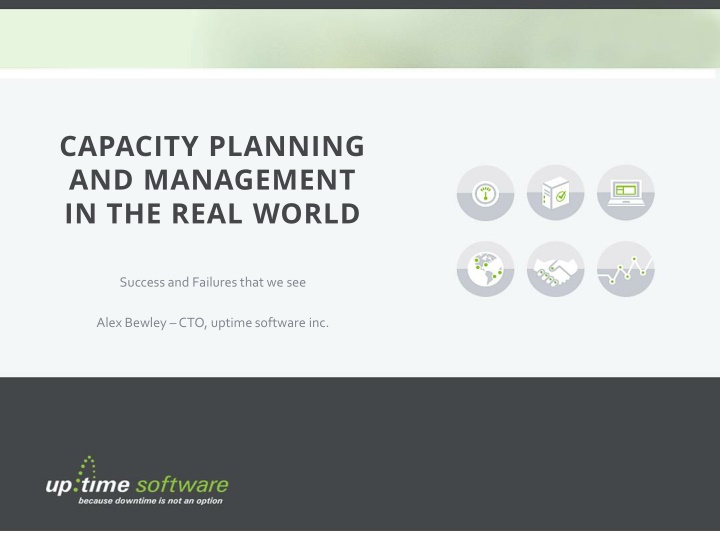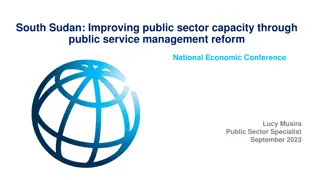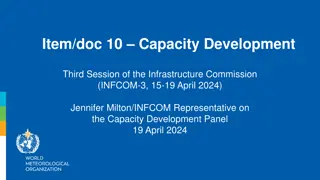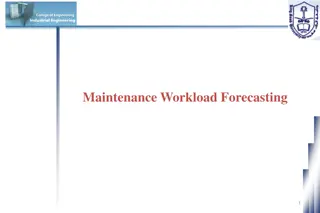CAPACITY PLANNING AND MANAGEMENT IN THE REAL WORLD
In the realm of capacity planning and management, examining the successes and failures encountered in real-world scenarios offers valuable insights. This discussion delves into diverse aspects such as historical usage trends, evolving strategies, and challenges faced by organizations as they navigate the complexities of optimizing resources and ensuring efficient operations. From addressing virtualization sprawl to refining workload analysis, the journey of capacity planners unfolds amidst a dynamic landscape shaped by technological advancements and shifting demands.
Download Presentation

Please find below an Image/Link to download the presentation.
The content on the website is provided AS IS for your information and personal use only. It may not be sold, licensed, or shared on other websites without obtaining consent from the author.If you encounter any issues during the download, it is possible that the publisher has removed the file from their server.
You are allowed to download the files provided on this website for personal or commercial use, subject to the condition that they are used lawfully. All files are the property of their respective owners.
The content on the website is provided AS IS for your information and personal use only. It may not be sold, licensed, or shared on other websites without obtaining consent from the author.
E N D
Presentation Transcript
CAPACITY PLANNING AND MANAGEMENT IN THE REAL WORLD Success and Failures that we see Alex Bewley CTO, uptime software inc. www.uptimesoftware.com
Why am I here? Been in the systems management business eighteen years uptime has over 150,000 systems (multiple-platforms) monitored across its customer base We detected a trend about ten years ago, customers used our tool for: Performance and availability monitoring Capacity planning Capacity planning??? Joined CMG in 2004 www.uptimesoftware.com
Capacity Planning: How are we doing? - Is It Time for Capacity Planners to Hang Up Their Cleats?. G. Jay Lipovich. Int. CMG Conference, page 237-248. Computer Measurement Group, (2005) - Gartner s Cameron Haight: perceptions of capacity planners: mysterious and using arcane tools, honest, but focused on minutiae, unapproachable and living in an ivory tower, old fashioned and living in the past, and my personal favorite, nerdy but generally harmless. www.uptimesoftware.com www.uptimesoftware.com
Is Capacity Planning Dead? Jevons Paradox: The more technology driven efficiency we have, the greater the amount of consumption. Virtualization sprawl and cloud sprawl are inevitable. Virtualization and cloud doesn t eliminate the need for capacity planning, it makes it more important. www.uptimesoftware.com
Historical Use of Capacity Planning We found was more about reclamation of underutilized resources When to consolidate workloads (hardware refresh) Use of analytics/modeling? Nope. The line is going up at this rate www.uptimesoftware.com
Capacity Planning Now Now more concrete mapping of cost to line-of-business Assistance with cost optimization, especially with Cloud (AWS) Instance sizing Reserved Instance optimized fit Workload analysis (batch? Spot instances) Required understanding of application architecture www.uptimesoftware.com
Largest Issues Data extraction sheer volume + mapping Agent vs. no agent, migration to API data extraction Consistent performance data no missing data Normalization across platforms (architecture) Understanding on virtualization (VMware, Hyper-V, Solaris, AIX LPARS) Presentation of data at scale Specialized metrics (i.e. TCP retransmit rate) www.uptimesoftware.com
Customer Case: Clearing Processor VMware s 3rd largest customer 12,000 systems, 750 ESX Application workloads + VDI Very large AIX systems Three capacity planners for org (compute, storage, network) Produce reports on ad-hoc basis as applications are reviewed or problems occur (week over week analysis) Two years of performance data retained (no aggregation) www.uptimesoftware.com
Customer Case: Bank trading floor 2,500 systems (Solaris, VMware) 75 line-of-business users Self-service + monthly reports Month over month analysis by LOB Cost tracking + usage is pushed onto LOBs Ad-hoc root-cause analysis Capacity planning team will investigate on-demand Migration from Solaris to VMware occurring www.uptimesoftware.com
Customer Challenges Building apps that scale Developers are unaware of impact on infrastructure Hard to pre-production test What about analytics and modeling? Not seeing it (doesn t mean it isn t happening) Is the capacity planning group responsible for the infrastructure? Centralized or push-down? Make LOBs responsible for their applications and workloads they have to correlate with cost and utilization Emergence of APM tooling How to integrate system performance/capacity with APM www.uptimesoftware.com
Key Take-aways Resolve yourself to never mention queuing theory again. Change the conversation to be business oriented. Understand the links between business metrics and IT develop links to your work. Lots of data, what s relevant? Improve communications about your efforts and results. Re-assess current processes to remove waste and increase agility. Begin mentoring of others that need capacity planning capabilities. www.uptimesoftware.com
Capacity Dashboard Map Dashboard Topology Dashboard Thank you. Thank you. alex.bewley@uptimesoftware.com @AlexBewley Global Scan Resource Scan www.uptimesoftware.com























